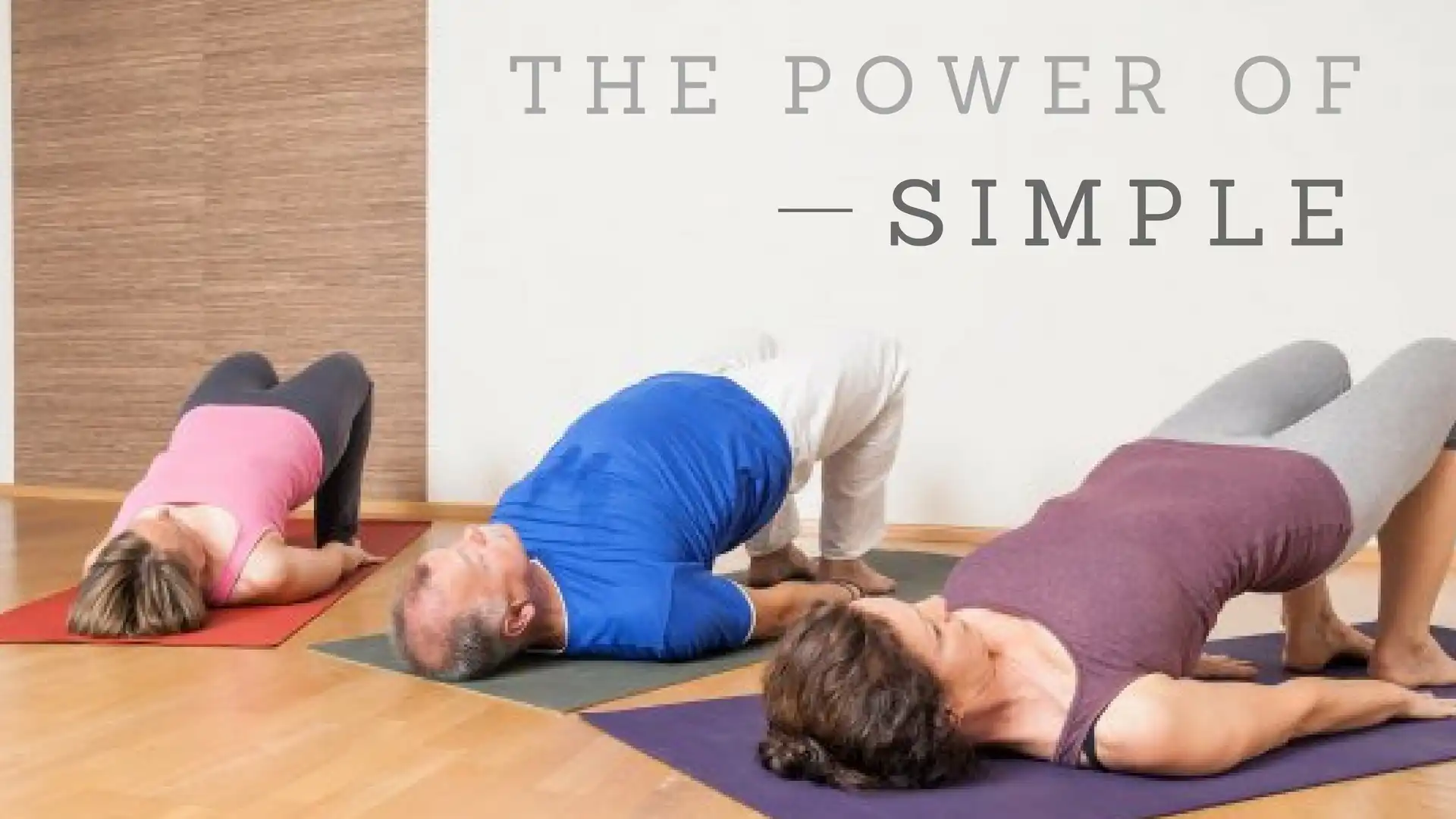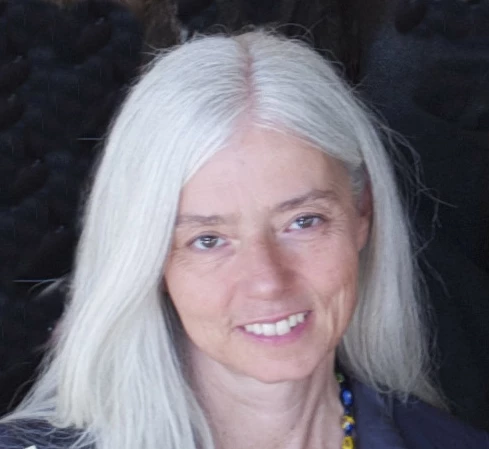The Power of Simple: Why I Teach Old-School Yoga

My History of Teaching Yoga
I began practicing yoga in 1982 at a modest studio behind the Sahara Hotel in Las Vegas. The teacher was June Bains, a trim, 60-something woman whose studio space had pink, plush carpet and no yoga mats, music or art on the walls. Still, it was a dedicated yoga space, something that was quite rare in those days.
What made me fall in love with yoga was the profound peace I felt when I left the class. After my very first class, I remember getting into my car and turning it on only to hear loud music blasting from the stereo I’d left on. I immediately turned off the radio. The peace I felt was far more compelling than any music could be.
My next yoga classes were in the social hall at the First Unitarian Church in Salt Lake City. Eliot Hall is a spacious, heavily used and well-loved space with a sprung maple dance floor. When my teachers left town in 1986, they gave me the precious gift of their yoga classes. I continued teaching in that space until a few years ago when Eliot Hall underwent a much-needed remodel.
Back in those days, there were no yoga studios in town. There were about a half dozen yoga teachers—I knew them all—teaching out of rented rooms, university and school gyms and classrooms (where you had to move desks out of the way before practicing), church basements and the like. There was no incense, no music, no yoga fashion. Like me, my students practiced yoga to calm their nerves and settle their minds. We wore whatever was most comfortable in the service of mobility. There was no yoga “scene.” Rather, there was just a committed group of students who relished the opportunity to be quiet and mindful, to slow their lives down for an hour and a half a week.
We moved slowly, mindful of each micromovement that made up each yoga pose. We stayed a while in poses, to allow our bodies to settle in to the point where we were no longer doing, but being the pose. People came to yoga practice because even though the poses were sometimes challenging, they left feeling a little smoother, a little quieter, a little happier than when they came.
The Pace Quickens
When the yoga boom happened, suddenly the intention for practice shifted. Yoga had to pick up the pace in order to fit into busy Western culture: Instead of practicing around a dozen poses in a class, we did a dozen poses per minute. We turned up the volume: Somewhere along the line, soundtracks combining raucous pop music and the burgeoning genre of yoga music accompanied our practice. We turned up the heat: Inspired by the popularity of Bikram yoga, studios of other types began turning up their thermostats to induce sweat. We turned up the fashion quotient: Pricey yoga clothing became a “necessity”—no more T-shirts and sweats. And Savasana, once a 10- to 15-minute respite designed to quiet the nervous system and allow for integration, was reduced to a two- to three-minute afterthought.
Why I Still Teach Old-School Yoga
While I’m happy to see yoga get the widespread recognition it deserves, I sometimes long for the simplicity of the old days. I wish I could say I still knew all the yoga teachers in town, like I did when there were fewer than 10 of us. There may be close to 1,000 in my town as of now. I know my classes seem like an anachronism, slow-paced with only the soundtrack of our own collective breath, in comfortable temperatures and with little attention to fashion other than for comfort. I’ve often wondered if I were to conform my classes to the Western evolution of yoga, if I would attract large numbers of students as the studios do.
Then I realize, probably not. Because the yoga that rings true for me and for my body/mind is old-school yoga. For me, yoga is not about burning calories, sweating or getting my butt kicked. Life already kicks my butt, as it does many of the people who attend my classes. Most of us are over-scheduled; we spend our days running from one appointment to the next. Most of us are over-stimulated and distracted; if we’re not actively distracting ourselves with electronic input, we are subject to electronic stimulation from others’ devices.
In other words, life kicks our collective butts enough already. Yoga practice is my time to replenish myself and relax my edgy nervous system. While it obviously is working for a whole lot of people—most of the population practicing yoga—fast-paced, sweaty yoga with loud music and high heat feels like the exact opposite of what I need.
I can only teach from my own practice. It would be completely out of integrity for me to teach a type of yoga I don’t do myself simply because it might bring in more students. I’m sure I wouldn’t be very good at teaching a fast-paced class either. It’s not my nature. And although it may be a much smaller population than the mainstream, there are still people who do seek a calm, quiet, non-competitive practice.
I teach old-school yoga because that is the yoga I love. It is my passion. My simple, slow-paced practice never fails to clear my body/mind, to make me feel clean, calm, energetic and easeful. My morning practice sets me up to meet my own wall-to-wall days from a deep core of peace.
Study with YogaUOnline and Dr. Tim McCall – Yoga as Medicine: A New Paradigm for Health.
This post was originally published on Hugger Mugger Yoga Products’ blog.
 Charlotte Bell began practicing yoga in 1982 and began teaching in 1986. She was certified by B.K.S. Iyengar in 1989 following a trip to Pune. In 1986, she began practicing Insight Meditation with her mentors Pujari and Abhilasha Keays. Her asana classes blend mindfulness with physical movement. Charlotte writes a column for Catalyst Magazine and serves as editor for Yoga U Online. She is the author of two books: Mindful Yoga, Mindful Life and Yoga for Meditators, both published by Rodmell Press. She also edits Hugger Mugger Yoga Products¹ blog and is a founding board member for GreenTREE Yoga, a non-profit that brings yoga to underserved populations. A lifelong musician, she plays oboe and English horn in the Salt Lake Symphony and the folk sextet Red Rock Rondo whose 2010 PBS music special won two Emmys.
Charlotte Bell began practicing yoga in 1982 and began teaching in 1986. She was certified by B.K.S. Iyengar in 1989 following a trip to Pune. In 1986, she began practicing Insight Meditation with her mentors Pujari and Abhilasha Keays. Her asana classes blend mindfulness with physical movement. Charlotte writes a column for Catalyst Magazine and serves as editor for Yoga U Online. She is the author of two books: Mindful Yoga, Mindful Life and Yoga for Meditators, both published by Rodmell Press. She also edits Hugger Mugger Yoga Products¹ blog and is a founding board member for GreenTREE Yoga, a non-profit that brings yoga to underserved populations. A lifelong musician, she plays oboe and English horn in the Salt Lake Symphony and the folk sextet Red Rock Rondo whose 2010 PBS music special won two Emmys.



